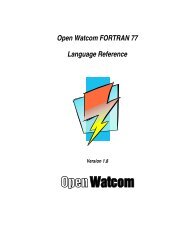Relocatable Object Module Format (OMF) Specification
Relocatable Object Module Format (OMF) Specification
Relocatable Object Module Format (OMF) Specification
Create successful ePaper yourself
Turn your PDF publications into a flip-book with our unique Google optimized e-Paper software.
<strong>Relocatable</strong> <strong>Object</strong> <strong>Module</strong> <strong>Format</strong><br />
The Fix Data bit layout is<br />
F Frame T P Targt<br />
1 3 1 1 2 (bits)<br />
and is interpreted as follows:<br />
F<br />
Frame<br />
T<br />
P<br />
Targt<br />
If F=1, the FRAME is given by a FRAME thread whose number is in the Frame field<br />
(modulo 4). There is no Frame Datum field in the subrecord.<br />
If F=0, the FRAME method (in the range F0 to F5) is explicitly defined in this FIXUP<br />
subrecord. The method is stored in the Frame field.<br />
A 3-bit numeric field, interpreted according to the F bit. The Frame Datum field is present<br />
and is an index field for FRAME methods F0, F1, and F2 only.<br />
If T=1, the TARGET is defined by a TARGET thread whose thread number is given in the<br />
2-bit Targt field. The Targt field contains a number between 0 and 3 that refers to a previous<br />
THREAD subrecord containing the TARGET method. The P bit, combined with the two loworder<br />
bits of the Method field in the THREAD subrecord, determines the TARGET method.<br />
If T=0, the TARGET is specified explicitly in this FIXUP subrecord. In this case, the P bit and<br />
the Targt field can be considered a 3-bit field analogous to the Frame field.<br />
Determines whether the Target Displacement field is present.<br />
If P=1, there is no Target Displacement field.<br />
If P=0, the Target Displacement field is present. It is a 4-byte field if the record type is 9DH;<br />
it is a 2-byte field otherwise.<br />
A 2-bit numeric field, which gives the lower two bits of the TARGET method (if T=0) or gives<br />
the TARGET thread number (if T=1).<br />
Frame Datum, Target Datum, and Target Displacement Fields<br />
The Frame Datum field is an index field that refers to a previous SEGDEF, GRPDEF, or EXTDEF record,<br />
depending on the FRAME method.<br />
Similarly, the Target Datum field contains a segment index, a group index, or an external name index, depending<br />
on the TARGET method.<br />
The Target Displacement field, a 16-bit or 32-bit field, is present only if the P bit in the Fix Data field is set to 0, in<br />
which case the Target Displacement field contains the offset used in methods 0, 1, and 2 of specifying a TARGET.<br />
Notes<br />
FIXUPP records are used to fix references in the immediately preceding LEDATA, LIDATA, or<br />
COMDAT record.<br />
The Frame field is the translator's way of telling the linker the contents of the segment register used for<br />
the reference; the TARGET is the item being referenced whose address was not completely resolved<br />
by the translator. In protected mode, the only legal segment register values are selectors; every<br />
segment and group of segments is mapped through some selector and addressed by an offset within<br />
the underlying memory defined by that selector.<br />
Examples<br />
For good examples of the usage of the FIXUP record, consult The MS-DOS Encyclopedia.<br />
46 <strong>OMF</strong> <strong>Specification</strong>, Version 1.1 Tool Interface Standards (TIS)
















